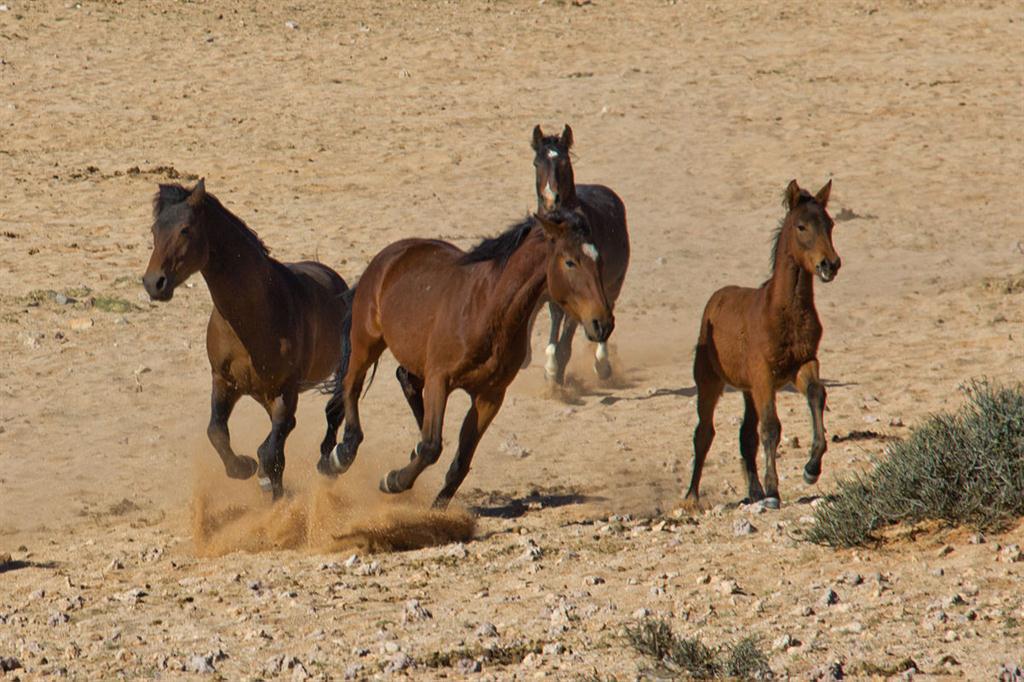Their 'extinction not an option'
The environment ministry is working on a solution that will reverse the steady decline of the wild horse population in the south of Namibia.
In a statement to the media yesterday afternoon, the environment ministry spokesperson Romeo Muyunda said the ministry is as concerned over the population of wild horses as members of the public.
“We concur with concerns that unless an urgent intervention is made, at the current rate of predation on the foals, the wild horse population will show no growth and could decline to an unsustainable population.” Muyunda said that there are currently 80 horses at Garub in the Namib-Naukluft Park, comprising 47 stallions and 33 mares. Since 2013, the horses have endured harsh conditions suffering both drought and predation by a clan of spotted hyaenas which moved into the area. “According to Dr Telane Greyling, who has studied the horses over the last 20 years, the hyaenas in 2013 alone, killed 100 animals of which half were foals. No foal has survived and the youngest horse in the population was born in 2012,” Muyunda said. The ministry, Muyunda said, is devising a solution that “will reverse this disturbing trend and ensure a healthy and sustainable population”. While good rains have fallen and this will bring relief, it will not have any impact on the hyaena population that will benefit the horses.
According to Muyunda, the ministry has found that relocating the horses is not viable but added, that they are “considering relocating the hyaenas in an attempt to safeguard the horses. However, this needs to be considered carefully not to disturb the natural ecosystem since the hyaenas are in their natural habitat. The ministry has in the past tried to intervene by feeding the hyaenas in an attempt to reduce predation.”
Muyunda said the ministry assures the public that they will respond swiftly to the ailing condition of the horses.
“We are aware of the tourism, environmental and economic value of these horses and their extinction is not an option.”
In a statement to the media yesterday afternoon, the environment ministry spokesperson Romeo Muyunda said the ministry is as concerned over the population of wild horses as members of the public.
“We concur with concerns that unless an urgent intervention is made, at the current rate of predation on the foals, the wild horse population will show no growth and could decline to an unsustainable population.” Muyunda said that there are currently 80 horses at Garub in the Namib-Naukluft Park, comprising 47 stallions and 33 mares. Since 2013, the horses have endured harsh conditions suffering both drought and predation by a clan of spotted hyaenas which moved into the area. “According to Dr Telane Greyling, who has studied the horses over the last 20 years, the hyaenas in 2013 alone, killed 100 animals of which half were foals. No foal has survived and the youngest horse in the population was born in 2012,” Muyunda said. The ministry, Muyunda said, is devising a solution that “will reverse this disturbing trend and ensure a healthy and sustainable population”. While good rains have fallen and this will bring relief, it will not have any impact on the hyaena population that will benefit the horses.
According to Muyunda, the ministry has found that relocating the horses is not viable but added, that they are “considering relocating the hyaenas in an attempt to safeguard the horses. However, this needs to be considered carefully not to disturb the natural ecosystem since the hyaenas are in their natural habitat. The ministry has in the past tried to intervene by feeding the hyaenas in an attempt to reduce predation.”
Muyunda said the ministry assures the public that they will respond swiftly to the ailing condition of the horses.
“We are aware of the tourism, environmental and economic value of these horses and their extinction is not an option.”





Comments
Namibian Sun
No comments have been left on this article